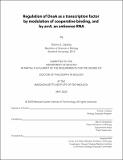| dc.contributor.advisor | Alan D. Grossman. | en_US |
| dc.contributor.author | Sedivy, Emma L.(Emma Louise) | en_US |
| dc.contributor.other | Massachusetts Institute of Technology. Department of Biology. | en_US |
| dc.date.accessioned | 2020-09-03T17:48:44Z | |
| dc.date.available | 2020-09-03T17:48:44Z | |
| dc.date.copyright | 2020 | en_US |
| dc.date.issued | 2020 | en_US |
| dc.identifier.uri | https://hdl.handle.net/1721.1/127137 | |
| dc.description | Thesis: Ph. D., Massachusetts Institute of Technology, Department of Biology, May, 2020 | en_US |
| dc.description | Cataloged from the official PDF of thesis. | en_US |
| dc.description | Includes bibliographical references (pages 82-96). | en_US |
| dc.description.abstract | DnaA is both the bacterial replication initiator and a transcription factor. Both activities are highly conserved and closely regulated. The mechanisms regulating its replication initiation activity have been well studied. Most organisms regulate both the abundance DnaA protein and its activity through a combination of evolutionarily divergent mechanisms. However, the mechanisms governing its role as a transcription factor are poorly understood, especially in Gram-positive organisms like Bacillus subtilis. I described the role of a small antisense RNA in the dnaA region, arrA, which represses dnaA. Mutation of the arrA promoter resulted in increased DnaA levels, which were insufficient to disrupt replication initiation but affected cellular physiology and expression of DnaA targets. In particular, arrA was required for proper sporulation. I also asked whether two of the previously described mechanisms regulating DnaA as the replication initiator in B. subtilis affect its activity as a transcriptional repressor. I found that forms of DnaA that are inhibited for replication initiation are still active transcriptional repressors. This interesting finding raises the possibility that some DnaA targets are regulated in a cell-cycle dependent manner, whereas others are repressed regardless of replication status. | en_US |
| dc.description.statementofresponsibility | by Emma L. Sedivy. | en_US |
| dc.format.extent | 96 pages | en_US |
| dc.language.iso | eng | en_US |
| dc.publisher | Massachusetts Institute of Technology | en_US |
| dc.rights | MIT theses may be protected by copyright. Please reuse MIT thesis content according to the MIT Libraries Permissions Policy, which is available through the URL provided. | en_US |
| dc.rights.uri | http://dspace.mit.edu/handle/1721.1/7582 | en_US |
| dc.subject | Biology. | en_US |
| dc.title | Regulation of DnaA as a transcription factor by modulation of cooperative binding, and by arrA, an antisense RNA | en_US |
| dc.type | Thesis | en_US |
| dc.description.degree | Ph. D. | en_US |
| dc.contributor.department | Massachusetts Institute of Technology. Department of Biology | en_US |
| dc.identifier.oclc | 1191838614 | en_US |
| dc.description.collection | Ph.D. Massachusetts Institute of Technology, Department of Biology | en_US |
| dspace.imported | 2020-09-03T17:48:44Z | en_US |
| mit.thesis.degree | Doctoral | en_US |
| mit.thesis.department | Bio | en_US |
